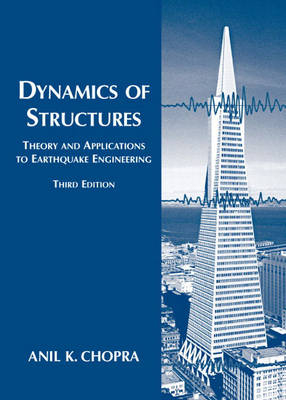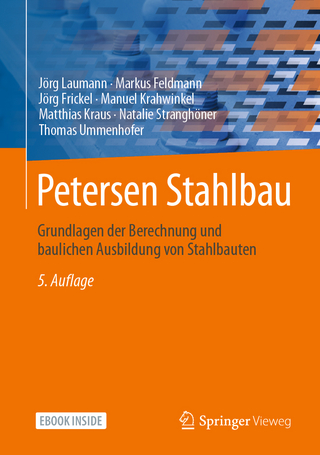
Dynamics of Structures
Pearson (Verlag)
978-0-13-156174-8 (ISBN)
- Titel erscheint in neuer Auflage
- Artikel merken
Contents
Foreword xxi
Preface xxiii
Preface to the Second Edition xxv
Preface to the First Edition xxvii
Acknowledgments xxxiii
PART I SINGLE-DEGREE-OF-FREEDOM SYSTEMS 1
1 Equations of Motion, Problem Statement, and Solution Methods 3
1.1 Simple Structures 3
1.2 Single-Degree-of-Freedom System 7
1.3 Force—Displacement Relation 8
1.4 Damping Force 12
1.5 Equation of Motion: External Force 14
1.6 Mass—Spring—Damper System 19
1.7 Equation of Motion: Earthquake Excitation 23
1.8 Problem Statement and Element Forces 26
1.9 Combining Static and Dynamic Responses 28
1.10 Methods of Solution of the Differential Equation 28
1.11 Study of SDF Systems: Organization 33
Appendix 1: Stiffness Coefficients for a Flexural Element 33
2 Free Vibration 39
2.1 Undamped Free Vibration 39
2.2 Viscously Damped Free Vibration 48
2.3 Energy in Free Vibration 56
2.4 Coulomb-Damped Free Vibration 57
3 Response to Harmonic and Periodic Excitations 65
Part A: Viscously Damped Systems: Basic Results 66
3.1 Harmonic Vibration of Undamped Systems 66
3.2 Harmonic Vibration with Viscous Damping 72
Part B: Viscously Damped Systems: Applications 85
3.3 Response to Vibration Generator 85
3.4 Natural Frequency and Damping from Harmonic Tests 87
3.5 Force Transmission and Vibration Isolation 90
3.6 Response to Ground Motion and Vibration Isolation 91
3.7 Vibration-Measuring Instruments 95
3.8 Energy Dissipated in Viscous Damping 99
3.9 Equivalent Viscous Damping 103
Part C: Systems with Nonviscous Damping 105
3.10 Harmonic Vibration with Rate-Independent Damping 105
3.11 Harmonic Vibration with Coulomb Friction 109
Part D: Response to Periodic Excitation 113
3.12 Fourier Series Representation 114
3.13 Response to Periodic Force 114
Appendix 3: Four-Way Logarithmic Graph
Paper 118
4 Response to Arbitrary, Step, and Pulse Excitations 125
Part A: Response to Arbitrarily Time-Varying Forces 125
4.1 Response to Unit Impulse 126
4.2 Response to Arbitrary Force 127
Part B: Response to Step and Ramp Forces 129
4.3 Step Force 129
4.4 Ramp or Linearly Increasing Force 131
4.5 Step Force with Finite Rise Time 132
Part C: Response to Pulse Excitations 135
4.6 Solution Methods 135
4.7 Rectangular Pulse Force 137
4.8 Half-Cycle Sine Pulse Force 143
4.9 Symmetrical Triangular Pulse Force 148
4.10 Effects of Pulse Shape and Approximate Analysis for Short Pulses 151
4.11 Effects of Viscous Damping 154
4.12 Response to Ground Motion 155
5 Numerical Evaluation of Dynamic Response 165
5.1 Time-Stepping Methods 165
5.2 Methods Based on Interpolation of Excitation 167
5.3 Central Difference Method 171
5.4 Newmark’s Method 174
5.5 Stability and Computational Error 180
5.6 Analysis of Nonlinear Response: Central Difference Method 184
5.7 Analysis of Nonlinear Response: Newmark’s Method 184
6 Earthquake Response of Linear Systems 197
6.1 Earthquake Excitation 197
6.2 Equation of Motion 203
6.3 Response Quantities 204
6.4 Response History 205
6.5 Response Spectrum Concept 207
6.6 Deformation, Pseudo-velocity, and Pseudo-acceleration Response Spectra 208
6.7 Peak Structural Response from the Response Spectrum 217
6.8 Response Spectrum Characteristics 222
6.9 Elastic Design Spectrum 230
6.10 Comparison of Design and Response Spectra 239
6.11 Distinction between Design and Response Spectra 241
6.12 Velocity and Acceleration Response Spectra 242
Appendix 6: ElCentro, 1940 Ground Motion 246
7 Earthquake Response of Inelastic Systems 257
7.1 Force—Deformation Relations 258
7.2 Normalized Yield Strength, Yield Strength Reduction Factor, and Ductility Factor 264
7.3 Equation of Motion and Controlling Parameters 265
7.4 Effects of Yielding 266
7.5 Response Spectrum for Yield Deformation and Yield Strength 273
7.6 Yield Strength and Deformation from the Response Spectrum 277
7.7 Yield Strength—Ductility Relation 277
7.8 Relative Effects of Yielding and Damping 279
7.9 Dissipated Energy 280
7.10 Energy Dissipation Devices 283
7.11 Inelastic Design Spectrum 288
7.12 Applications of the Design Spectrum 295
7.13 Comparison of Design and Response Spectra 301
8 Generalized Single-Degree-of-Freedom Systems 305
8.1 Generalized SDF Systems 305
8.2 Rigid-Body Assemblages 307
8.3 Systems with Distributed Mass and Elasticity 309
8.4 Lumped-Mass System: Shear Building 321
8.5 Natural Vibration Frequency by Rayleigh’s Method 328
8.6 Selection of Shape Function 332
Appendix 8: Inertia Forces for Rigid Bodies 336
PART II MULTI-DEGREE-OF-FREEDOM SYSTEMS 343
9 Equations of Motion, Problem Statement, and Solution
Methods 345
9.1 Simple System: Two-Story Shear Building 345
9.2 General Approach for Linear Systems 350
9.3 Static Condensation 367
9.4 Planar or Symmetric-Plan Systems: Ground Motion 370
9.5 Unsymmetric-Plan Buildings: Ground Motion 375
9.6 Symmetric-Plan Buildings: Torsional Excitation 383
9.7 Multiple Support Excitation 384
9.8 Inelastic Systems 389
9.9 Problem Statement 389
9.10 Element Forces 390
9.11 Methods for Solving the Equations of Motion: Overview 390
10 Free Vibration 401
Part A: Natural Vibration Frequencies and Modes 402
10.1 Systems without Damping 402
10.2 Natural Vibration Frequencies and Modes 404
10.3 Modal and Spectral Matrices 406
10.4 Orthogonality of Modes 407
10.5 Interpretation of Modal Orthogonality 408
10.6 Normalization of Modes 408
10.7 Modal Expansion of Displacements 418
Part B: Free Vibration Response 419
10.8 Solution of Free Vibration Equations: Undamped Systems 419
10.9 Free Vibration of Systems with Damping 422
10.10 Solution of Free Vibration Equations: Classically Damped Systems 426
Part C: Computation of Vibration Properties 428
10.11 Solution Methods for the Eigenvalue Problem 428
10.12 Rayleigh’s Quotient 430
10.13 Inverse Vector Iteration Method 430
10.14 Vector Iteration with Shifts: Preferred Procedure 435
10.15 Transformation of kφ = ω2mφ to the StandardForm 440
11 Damping in Structures 447
Part A: Experimental Data and Recommended Modal Damping Ratios 447
11.1 Vibration Properties of Millikan Library Building 447
11.2 Estimating Modal Damping Ratios 452
Part B: Construction of Damping Matrix 454
11.3 Damping Matrix 454
11.4 Classical Damping Matrix 455
11.5 Nonclassical Damping Matrix 463
12 Dynamic Analysis and Response of Linear Systems 467
Part A: Two-Degree-of-Freedom Systems 467
12.1 Analysis of Two-DOF Systems without Damping 467
12.2 Vibration Absorber or Tuned Mass Damper 470
Part B: Modal Analysis 472
12.3 Modal Equations for Undamped Systems 472
12.4 Modal Equations for Damped Systems 475
12.5 Displacement Response 476
12.6 Element Forces 477
12.7 Modal Analysis: Summary 477
Part C: Modal Response Contributions 482
12.8 Modal Expansion of Excitation Vectorp(t) = sp(t) 482
12.9 Modal Analysis for p(t) = sp(t) 486
12.10 Modal Contribution Factors 487
12.11 Modal Responses and Required Number of Modes 489
Part D: Special Analysis Procedures 496
12.12 Static Correction Method 496
12.13 Mode Acceleration Superposition Method 499
12.14 Analysis of Nonclassically Damped Systems 500
13 Earthquake Analysis of Linear Systems 507
Part A: Response History Analysis 508
13.1 Modal Analysis 508
13.2 Multistory Buildings with Symmetric Plan 514
13.3 Multistory Buildings with Unsymmetric Plan 533
13.4 Torsional Response of Symmetric-Plan Buildings 544
13.5 Response Analysis for Multiple Support Excitation 548
13.6 Structural Idealization and Earthquake Response 554
Part B: Response Spectrum Analysis 555
13.7 Peak Response from Earthquake Response Spectrum 555
13.8 Multistory Buildings with Symmetric Plan 560
13.9 Multistory Buildings with Unsymmetric Plan 572
14 Reduction of Degrees of Freedom 593
14.1 Kinematic Constraints 594
14.2 Mass Lumping in Selected DOFs 595
14.3 Rayleigh—Ritz Method 595
14.4 Selection of Ritz Vectors 599
14.5 Dynamic Analysis Using Ritz Vectors 604
15 Numerical Evaluation of Dynamic Response 609
15.1 Time-Stepping Methods 609
15.2 Analysis of Linear Systems with Nonclassical Damping 611
15.3 Analysis of Nonlinear Systems 618
16 Systems with Distributed Mass and Elasticity 629
16.1 Equation of Undamped Motion: Applied Forces 630
16.2 Equation of Undamped Motion: Support Excitation 631
16.3 Natural Vibration Frequencies and Modes 632
16.4 Modal Orthogonality 639
16.5 Modal Analysis of Forced Dynamic Response 641
16.6 Earthquake Response History Analysis 648
16.7 Earthquake Response Spectrum Analysis 653
16.8 Difficulty in Analyzing Practical Systems 656
17 Introduction to the Finite Element Method 661
Part A: Rayleigh—Ritz Method 661
17.1 Formulation Using Conservation of Energy 661
17.2 Formulation Using Virtual Work 665
17.3 Disadvantages of Rayleigh—Ritz Method 667
Part B: Finite Element Method 667
17.4 Finite Element Approximation 667
17.5 Analysis Procedure 669
17.6 Element Degrees of Freedom and InterpolationFunctions 671
17.7 Element Stiffness Matrix 672
17.8 Element Mass Matrix 673
17.9 Element (Applied) Force Vector 675
17.10 Comparison of Finite Element and ExactSolutions 679
17.11 Dynamic Analysis of Structural Continua 680
PART III EARTHQUAKE RESPONSE AND DESIGN OF
MULTISTORY BUILDINGS 687
18 Earthquake Response of Linearly Elastic Buildings 689
18.1 Systems Analyzed, Design Spectrum, and Response Quantities 689
18.2 Influence of T1 and ¿ on Response 694
18.3 Modal Contribution Factors 695
18.4 Influence of T1 on Higher-Mode Response 697
18.5 Influence of ¿ on Higher-Mode Response 700
18.6 Heightwise Variation of Higher-Mode Response 701
18.7 How Many Modes to Include 703
19 Earthquake Analysis and Response of Inelastic Buildings 707
Part A: Nonlinear Response History Analysis 708
19.1 Equations of Motion: Formulation and Solution 708
19.2 Computing Seismic Demands: Factors
To Be Considered 709
19.3 Story Drift Demands 713
19.4 Strength Demands for SDF and MDF Systems 719
Part B: Approximate Analysis Procedures 720
19.5 Motivation and Basic Concept 720
19.6 Uncoupled Modal Response History Analysis 722
19.7 Modal Pushover Analysis 729
19.8 Evaluation of Modal Pushover Analysis 734
19.9 Simplified Modal Pushover Analysis for Practical Application 739
20 Earthquake Dynamics of Base-Isolated Buildings 741
20.1 Isolation Systems 741
20.2 Base-Isolated One-Story Buildings 744
20.3 Effectiveness of Base Isolation 750
20.4 Base-Isolated Multistory Buildings 754
20.5 Applications of Base Isolation 760
21 Structural Dynamics in Building Codes 767
Part A: Building Codes and Structural Dynamics 768
21.1 International Building Code (United States), 2006 768
21.2 National Building Code of Canada, 2005 771
21.3 Mexico Federal District Code, 2004 773
21.4 Eurocode 8, 2004 775
21.5 Structural Dynamics in Building Codes 778
Part B: Evaluation of Building Codes 784
21.6 Base Shear 784
21.7 Story Shears and Equivalent Static Forces 788
21.8 Overturning Moments 790
21.9 Concluding Remarks 793
22 Structural Dynamics in Building Evaluation Guidelines 795
22.1 Nonlinear Dynamic Procedure: Current Practice 796
22.2 SDF-System Estimate of Roof Displacement 797
22.3 Estimating Deformation of Inelastic SDF Systems 799
22.4 Nonlinear Static Procedure 806
22.5 Concluding Remarks 812
A Frequency-Domain Method of Response Analysis 815
B Notation 837
C Answers to Selected Problems 849
Index 865
| Erscheint lt. Verlag | 15.9.2006 |
|---|---|
| Sprache | englisch |
| Maße | 241 x 181 mm |
| Gewicht | 1434 g |
| Themenwelt | Technik ► Bauwesen |
| ISBN-10 | 0-13-156174-X / 013156174X |
| ISBN-13 | 978-0-13-156174-8 / 9780131561748 |
| Zustand | Neuware |
| Informationen gemäß Produktsicherheitsverordnung (GPSR) | |
| Haben Sie eine Frage zum Produkt? |
aus dem Bereich



